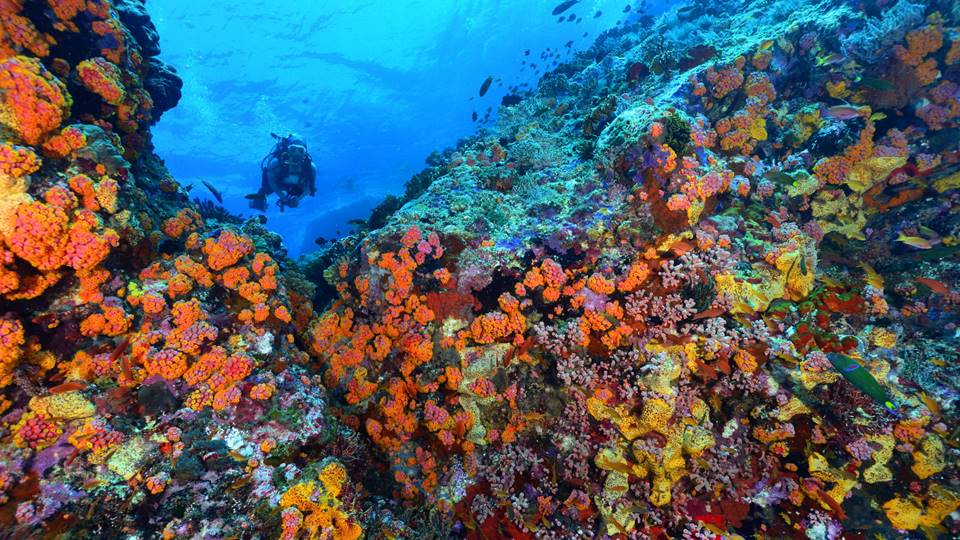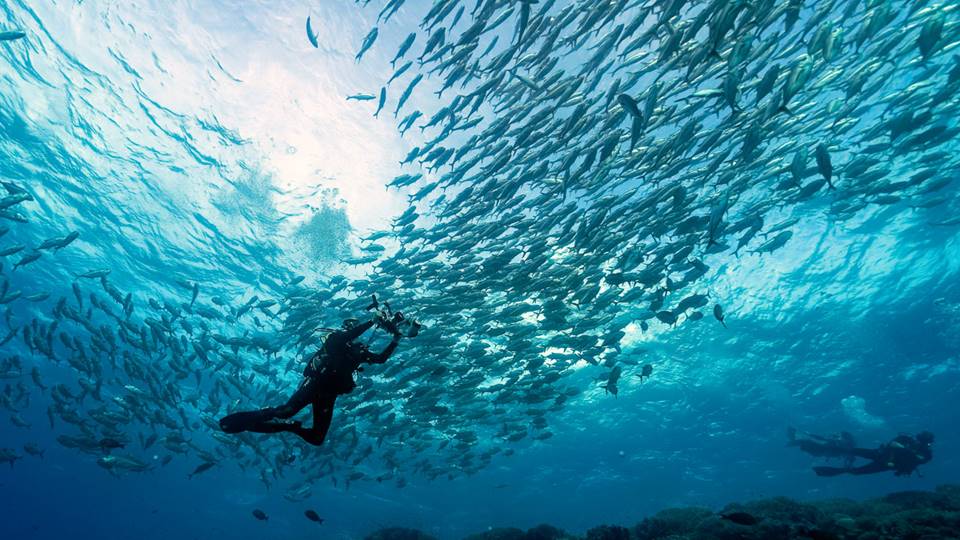Tubbataha Reef: Exploring the World’s Most Beautiful Marine Reserve

Tubbataha Reef Natural Park is a marine protected area and world-renowned scuba diving site. It is home to more than 1,200 marine species, including sea grasses, algae, corals, sharks, rays, fishes, sea turtles, seabirds, and marine mammals.
Tubbataha Reef is in the middle of the Sulu Sea, 171 km south of Palawan Island in the Philippines.
Three significant areas make up Tubbataha Reef:
- North Atoll
- South Atoll
- Jessy Beazley Reef
Each atoll has various diving locations, making a Tubbataha Reef liveaboard the best and the only way to see them all. Furthermore, the never-ending show of multicolored reef fish, lobsters, and stingrays will astound divers on a liveaboard to Tubbataha.
Large oceanic like giant trevally, tuna, barracuda, manta rays, and turtles congregate on the southern side of North Atoll. The wrecks on both atolls are great for macro species, including pygmy seahorses, nudibranchs, and tiny crabs. The South Atoll is a great place to see hammerhead sharks.
Another ideal area for hammerhead sharks, as well as for other shark species, is the northwestern Jessie Beazley Reef. The swift currents support significantly branched hard corals and all the related marine life.
When to dive into Tubbataha Reef? When’s the best time of year?
Tubbataha Reef is only accessible from March to June each year. As such, demand is high for the handful of liveaboards that go there. You can check pricing and availability for Tubbataha liveaboards this season or next.
TUBBATAHA BEST DIVE SPOTS

Scuba diving in Tubbataha is a visual feast. Each Tubbataha Reef National Park dive site boasts a unique range of species to discover.
Here are the top best dive sites in Tubbataha Reef:
1. Amos Rock:
- Features:
- You will see various types of beautiful corals and massive Gorgonian fans.
- The fascinating Napoleon wrasses.
- Large fish such as:
- snappers
- mackerels
- groupers
2. Washing Machine
- Want to see sharks and manta rays?
- You can go to the Washing Machine in the North Atoll to ride the currents and see them!
- Washing Machine is the best place for shark cage diving.
3. Malayan Wreck
- Get some great shots at Malayan for nudibranchs, crabs, and shrimps.
- Wreck divers will also get their dose of adventure and exploration.
- Check out the list of the best shipwrecks to scuba dive.
4. Seafan Alley
- Want to see colorful coral reefs? Go to Seafan Alley in the North Atoll to see Gorgonian sea fans (keep a lookout for pygmy seahorses!)
5. Shark Airport
- For great shark diving, head to Shark Airport.
- It is where you’ll find them either swimming around or resting along the reef.
The Ultimate Guide on How to Reach Tubbataha Reef
Tubbataha Reef is in the southwestern part of the Philippines.
The quickest route there is via plane, stopping in Manila.
Fly to Puerto Princesa:
You can fly from Manila to Puerto Princesa International Airport (PPS).
Several airlines operate flights between Manila and Puerto Princesa, including:
- Philippine Airlines
- Cebu Pacific
- AirAsia.
The flight takes around 1 hour and 15 minutes.
Upon Arrival:
Take a van or tricycle to either the town of El Nido or the municipality of Sabang, the two main jump-off points to reach Tubbataha Reef.
Take a LIVEABOARD to Tubbataha Reef:
- The primary way to reach Tubbataha Reef is through a liveaboard dive boat, as it is a remote and protected marine sanctuary.
- The boat ride takes around 10 to 12 hours, depending on the weather conditions.
- Several tour operators offer boat trips to Tubbataha Reefs, and they usually depart from Puerto Princesa Bay.
- It’s necessary to book your boat trip in advance, as the number of visitors to Tubbataha Reefs is limited.
- You can search for licensed tour operators online or through travel agencies to book a liveaboard trip.
Liveaboard Transportation to the Reef:
Due to the park’s isolation in the Sulu Sea, only liveaboards operated by Tubbataha can transport visitors there.
Moreover, it takes approximately 10-12 hours from Puerto Princesa to get to TRNP. In addition, visitors usually stay for days in Tubbataha to make the most of their trip.
I. MV RESOLUTE:
- From March to June, this liveaboard journeys to Tubbataha, offering five days of diving in the UNESCO heritage site’s atolls and reefs.
II. M/Y AZALEA PHILIPPINES:
- The pristine Tubbatha Reefs are accessible only by liveaboard, and with only nine other divers on board, they ensure a peaceful and uncrowded experience.
- Expect to see manta rays, multiple species of sharks, turtles, dolphins, whales, and hundreds of species of fish and coral.
III. INFINITI
- Dive into the world-class Tubbataha Reef and search for big fish, macro life, sea walls, and fascinating wrecks.
- Boat Amenities:
- En-Suite Bathroom
- Air-Conditioning
- Spacious Diving Platform
IV. M/V SEADOORS:
- M/V Seadoors is a pleasant 25 meters / 82 feet, European-operated, no-frills Philippines liveaboard tour boat focused on diving.
- Both Nitrox and Rebreather facilities are available for Certified Divers during the trips offered in the Tubbataha Reefs Natural Park and other diving sites.
Tubbataha Reef Adventure: Where to Stay and Relax
I. Blue Palawan Beach Club:
- The beachfront resort is in Puerto Princesa City.
- It is about 1.5 hours away from Tubbataha Reefs.
- It’s an excellent option for those who want to combine a diving adventure with a beach vacation.
II. Dolarog Beach Resort
- It is a budget-friendly resort in Port Barton, about 4 hours away from Tubbataha Reefs.
- It provides a tranquil and relaxed atmosphere ideal for people who want to discover Palawan’s natural beauties.
III. Flower Island Resort
- It is a remote resort on a private island in Taytay.
- It is about 3 hours away from Tubbataha Reefs.
IV. Dos Palmas Island Resort and Spa
- You can locate this resort on a private island in Honda Bay, Puerto Princesa.
- It is about 2 hours away from Tubbataha Reefs.
- It offers a variety of activities, including diving, snorkeling, and island hopping.
V. Coral Bay Beach and Dive Resort
- The resort is about 4 hours away from Tubbataha Reefs.
- It offers a quiet ambiance that is ideal for individuals looking to get away from the crowds.
Dive into Tubbataha Reef: Top Things to Do
FREEDIVING AND SNORKELING
- In addition to scuba diving, Tubbataha Reefs guests can go snorkeling and freediving.
RANGER STATION VISIT
- There are often 10–8 marine park officers on duty.
- They patrol the area 24/7 and help in research and scientific studies.
- Also, they manage visitors, do surface and underwater cleanups, and handle administrative tasks.
BIRDWATCHING
- The islets in Tubbataha are nesting sites for migratory and resident seabird species.
- It is said to be the last of the few remaining intact seabird habitats and breeding grounds in Southeast Asia.
DRONE FLYING
- Flying a drone is another activity in Tubbataha Reefs Natural Park.
- If you are a drone pilot and enjoy taking videos and photos of the ocean from the topside, this is an excellent place to do it.
- Before your trip, get a drone permit to fly in Tubbataha.
The Do’s and Don’ts
- Your weight matters. Always check that you are appropriately weighted and practice your buoyancy control in an area where you cannot damage anything.
- Observe distance. Brushing against a coral could give you a painful scratch but may kill fragile coral polyps.
- Don’t touch marine life and avoid wearing gloves – gloved divers tend to feel marine life recklessly.
- Don’t chase, grab or block the path of any free-swimming animal – imagine how you’d feel if a shark were to do that to you!
- Only collect something from within the park. Thus, even dead corals and shells are home to other marine organisms.
- Don’t disturb the sand – sediment, and sand that land on living corals can smother and kill them.
- Do not leave your trash. Please pick up any litter in or out of the water.
- Avoid harming any marine creatures while looking for that perfect shot.
